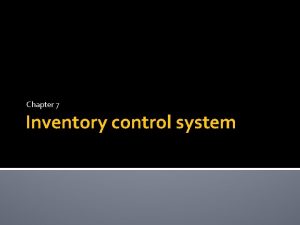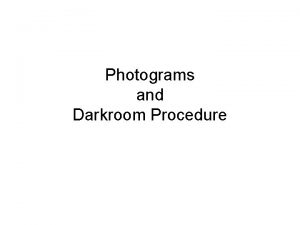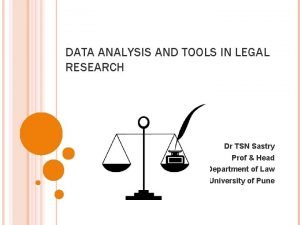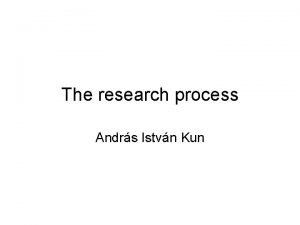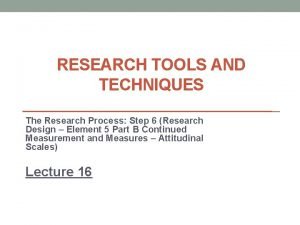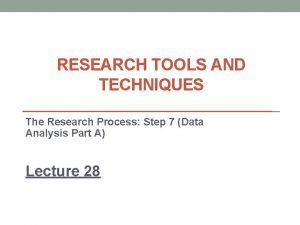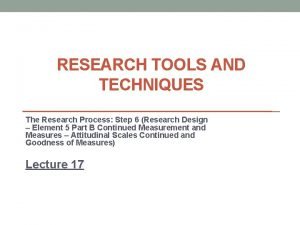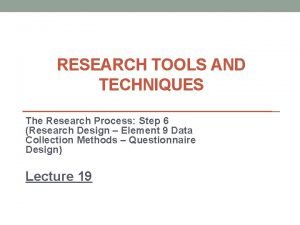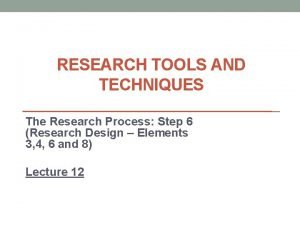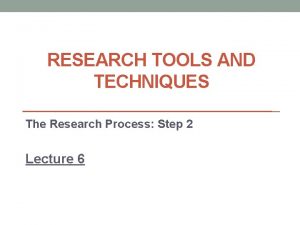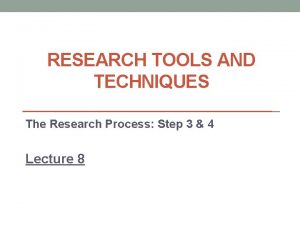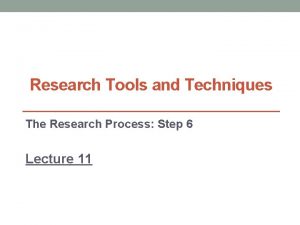RESEARCH TOOLS AND TECHNIQUES The Research Process Step















- Slides: 15

RESEARCH TOOLS AND TECHNIQUES The Research Process: Step 7 (Data Analysis Part B) Lecture 29

Lecture Topics Covered Previously in the Last Lecture • Introduction to Descriptive Statistics • Measures of Central Tendency • Measures of Dispersion

What we are going to Cover in this Lecture • Methods of Bivariate Analysis • Contingency tables • X 2 Test • Pearson’s Correlation

THE RESEARCH PROCESS (1). Observation The Broad Problem Area (2). Preliminary Data Gathering Interviews and Library Search (3). (4). Theoretical Framework Problem Definition Variables Identification (5) (6). Scientific Research Design Generation of Hypothesis (7). Data Collection and Analysis (8) Deduction (9). (10). (11). Report Writing Report Presentation Managerial Decision Making

Introduction to Data Analysis Process Data Collection Data Analysis Process Interpretation of Results Data Analysis Discussion Getting Data Ready for Analysis Feel for Data 1. Mean Editing Data 2. Median 1. Incompleteness /omissions 3. Mode 2. Inconsistencies 5. Frequency Distribution 3. Legibility 4. Coding Data 5. Categorizing 6. Creating a Data File 4. Variance Recommendations Hypotheses Testing Appropriate Statistical Manipulation (Inferential Statistics) Goodness of Data 1. Reliability 2. Validity

STATISTICAL DATA ANALYSIS • BIVARIATE ANALYSIS: In this statistical analysis, the two variables are analyzed at a time in order to understand whether or not they are related. The hypotheses are tested applying this technique. • MULTIVARIATE ANALYSIS: Statistical procedures that simultaneously analyze multiple measurements (Three or more variables) on each individual or object under study. It is the further extension of univariate and bivariate statistical procedures previously stated.

Methods of Bivariate Analysis Nominal Ordinal Interval/Ratio Dichotomo us Nominal +Contingency Table +Chi Square +Cramer’s V If the interval/ratio variable is the dependent variable, Compare Means+Eta +Contingency Table +Chi Square +Cramer’s V Ordinal +Contingency Table +Chi Square +Cramer’s V Spearman’s rho Interval/Ratio +Contingency Table +Chi Square +Cramer’s V If the interval/ratio variable is the dependent variable, Compare Means+Eta Spearman’s rho Pearson’s r Spearman’s rho Dichotomous +Contingency Table +Chi Square+ Crm V Spearman’s rho Phi

Contingency Tables (A Bivariate Mode of Analysis) Reasons for Visiting Gym Gender No. % Relaxation 3 7 6 13 Fitness 15 36 16 33 Lose Weight 8 19 25 52 Build Strength 16 38 1 2 Total 42 100 48 100 Male Female The cross tabulation / contingency table is like a frequency table but it allows two variables to be simultaneously analyzed so that patterns of association can be searched between them. Here in this example two category/nominal variables are analyzed simultaneously.

X 2 Test Table of Observed Values Table of Expected Values Do Watch Television Do Not Watch Television Total Morning Shift 45 5 50 Evening Shift 47 3 50 Night Shift 40 10 50 Total 132 18 150 Do Watch Television (B 1) Do Not Watch Television (B 2) Total Morning Shift (A 1) 132 x 50/ 150 = 44 6 50 Evening Shift (A 2) 44 6 50 Night Shift (A 3) 44 6 50 Total 132 18 150 Ho = The two criteria are independent Ha = The two criteria are associated with one another Level of significance α = 0. 05 Test Statistics Used is x 2 = 3εi=1 2εj=1 (oij – eij)2 / eij Degree of Freedom: (3 -1)(2 -1) 2 x 1 = 2

X 2 - Statistical Table oij eij oij-eij (oij-eij)2 /eij 45 44 1 1 0. 02 47 44 3 9 0. 2 40 44 -4 16 2. 66 5 6 -1 1 0. 16 3 6 -3 9 1. 5 10 6 4 16 2. 66 150 - - 7. 2 From the table critical region x 2 0. 05, (2) =5. 99 X 2 Cal = 7. 2 As x 2 Cal > x 2 0. 05, (2) 7. 2>5. 99 The Null hypothesis failed to get substantiated “The data provided statistical association between the variables of interest”

Pearson’s R Coefficient will lie between -1 0 +1 Y Y Y Age Perfect Positive Relationship +1 Use of Cardiovascular Equipment X Perfect Negative Age X No Relationship 0 Relationship -1 Correlation Coefficient: A quantitative description of the magnitude and direction of the linear relationship between two variables. Spearman’s Rho is just like Pearson’s R which is used for the data collected on Interval and Ratio Scales Variables whereas Rho is used for the Ordinal Scale Variables.

X 6 9 4 2 4 Y (X-X) 3 1 10 4 7 -1 4 -3 6 -1 (Y-Y) -3 4 1 -2 0 (X-X)(Y-Y) -3 16 -1 6 0 S=25 S=30 S=0 S=18 X=5 Y=6

X 6 9 4 2 4 Y (X-X)2 (Y-Y)2 3 1 9 10 16 16 7 1 1 4 9 4 6 1 0 S=25 S=30 S=28 S=30 (28 x 30=840) X=5 Y=6 Corxy = 18 = . 62 Ö 840 29

Correlations between Employee’s Years in Service and Years with the Company, Senior Managers and Middle Managers, Bank Alfalah, 2010 Years With Company Managerial Position Senior Managers Years In Service Pearson Correlation . 054 Sig. (2 -tailed) . 725 N Middle Managers Years In Service Pearson Correlation Sig. (2 -tailed) N 45. 540(**). 000 65 ** Correlation is significant at the 0. 01 level (2 -tailed). Phi and Cramer’s V: For dichotomous (phi) variables. Cramer’s V is for nominal variables but only in positive, indicates strength of relationship.

Summary • Methods of Bivariate Analysis • Contingency tables • X 2 Test • Pearson’s Correlation
 Step 1 step 2 step 3 step 4
Step 1 step 2 step 3 step 4 Step by step tools
Step by step tools The process of photosynthesis step by step
The process of photosynthesis step by step Step-by step inventory process
Step-by step inventory process Photogram process
Photogram process Process of making apple juice step by step
Process of making apple juice step by step Fabric process step by step
Fabric process step by step Step 1 in 7 step improvement process
Step 1 in 7 step improvement process Monitor communications process tools and techniques
Monitor communications process tools and techniques Tools how to legal research
Tools how to legal research Sine function graph
Sine function graph Two step inequalities
Two step inequalities Solve two step inequalities
Solve two step inequalities 8 step model of research process
8 step model of research process Marketing research process
Marketing research process Disking of primary teeth
Disking of primary teeth



